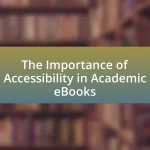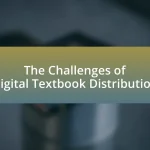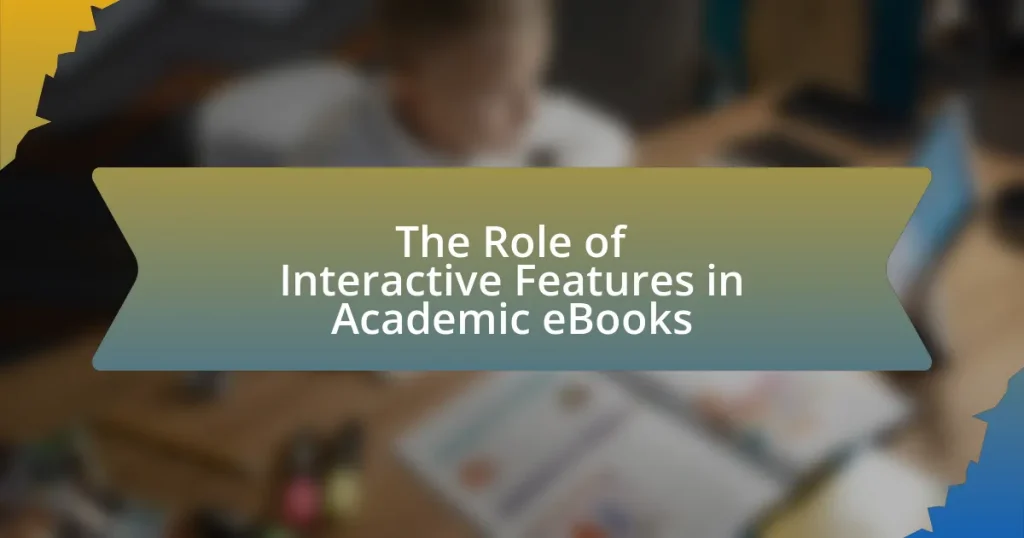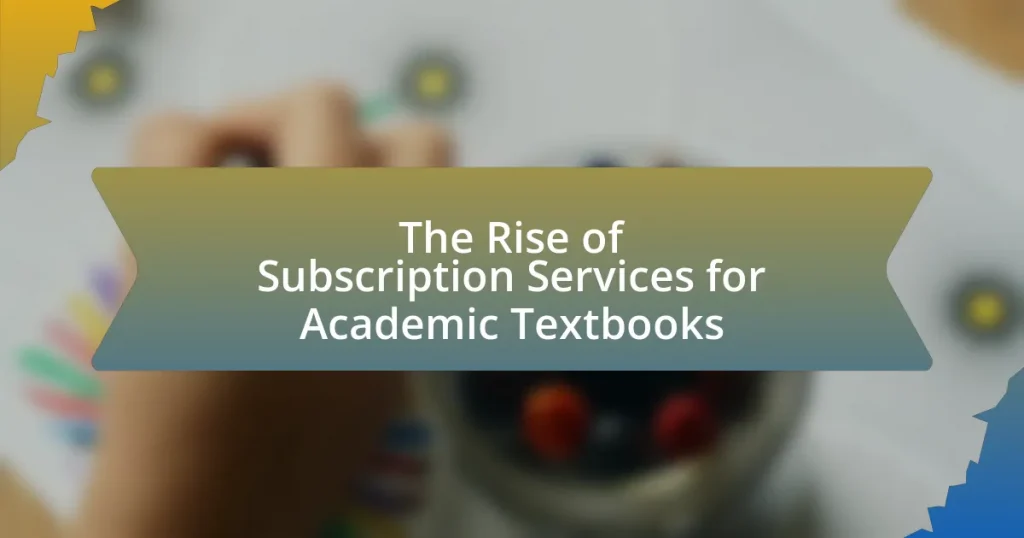The Academic eBook Market encompasses the production, distribution, and consumption of electronic books tailored for educational and scholarly use, with a projected growth from approximately $3.5 billion in 2020 to around $7.5 billion by 2026. This article explores the evolution of the market, driven by technological advancements and changing consumer behaviors, highlighting key components such as content providers, distribution platforms, and user demographics. It also examines current trends, the role of libraries, and the implications of market statistics for stakeholders, while providing insights into effective strategies for publishers and educators in navigating this rapidly evolving landscape.
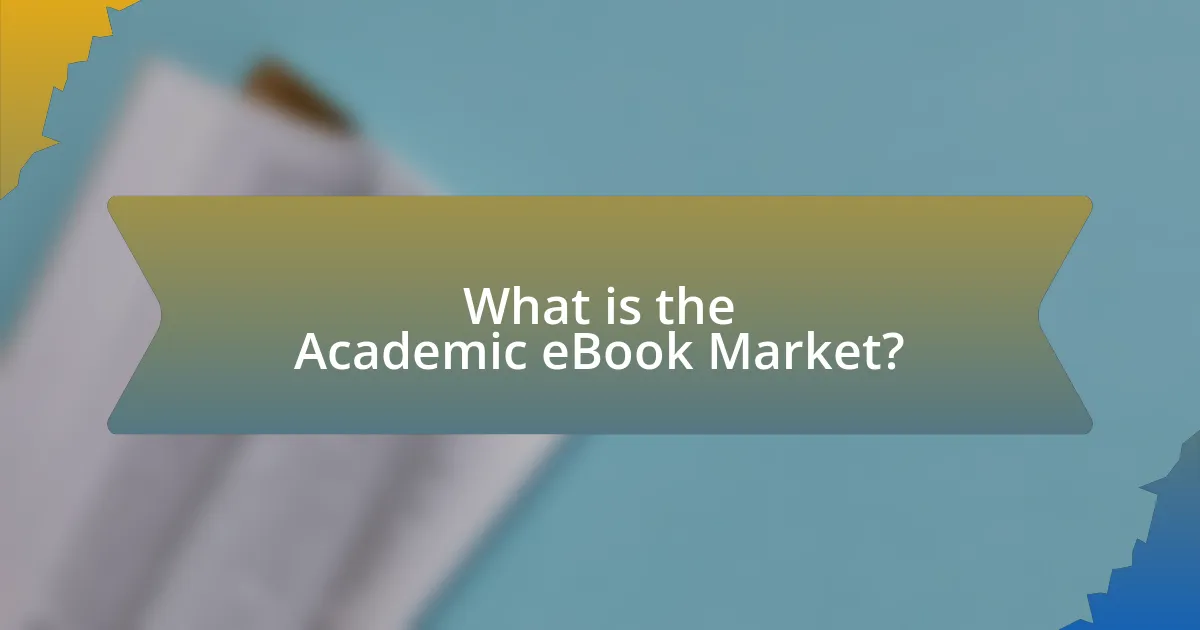
What is the Academic eBook Market?
The Academic eBook Market refers to the sector that encompasses the production, distribution, and consumption of electronic books specifically designed for educational and scholarly purposes. This market has experienced significant growth, driven by the increasing adoption of digital learning resources in educational institutions. According to a report by Research and Markets, the global academic eBook market was valued at approximately $3.5 billion in 2020 and is projected to reach around $7.5 billion by 2026, reflecting a compound annual growth rate (CAGR) of 13.5%. This growth is fueled by factors such as the rising demand for accessible learning materials, the proliferation of mobile devices, and the shift towards online education.
How has the Academic eBook Market evolved over time?
The Academic eBook Market has evolved significantly over the past two decades, transitioning from a niche segment to a mainstream resource in educational institutions. Initially, academic eBooks were limited in availability and often faced resistance from traditional print formats; however, advancements in technology and increasing internet accessibility have driven their adoption. According to a 2021 report by the International Publishers Association, the global academic eBook market was valued at approximately $6 billion, reflecting a compound annual growth rate of around 15% since 2015. This growth is attributed to the rising demand for digital resources, particularly during the COVID-19 pandemic, which accelerated the shift towards online learning and remote access to educational materials. Furthermore, the integration of interactive features and enhanced accessibility options has made academic eBooks more appealing to both educators and students, solidifying their role in modern academia.
What technological advancements have influenced the Academic eBook Market?
Technological advancements such as the proliferation of mobile devices, cloud computing, and enhanced digital rights management have significantly influenced the Academic eBook Market. The widespread use of smartphones and tablets has made eBooks more accessible to students and educators, facilitating on-the-go learning. Cloud computing allows for seamless storage and sharing of eBooks, enabling institutions to manage large libraries efficiently. Additionally, advancements in digital rights management protect intellectual property while allowing for flexible licensing models, which has encouraged publishers to invest in eBook development. These factors collectively contribute to the growth and evolution of the Academic eBook Market.
How do changes in consumer behavior impact the Academic eBook Market?
Changes in consumer behavior significantly impact the Academic eBook Market by influencing purchasing patterns, content preferences, and pricing strategies. For instance, the shift towards digital learning and remote education has increased demand for eBooks, with a report from the Association of American Publishers indicating a 16% growth in eBook sales in the education sector in 2020. Additionally, consumers are increasingly favoring subscription models over outright purchases, prompting publishers to adapt their business models to include services like academic eBook subscriptions, which cater to the evolving preferences for access over ownership. This shift is further supported by data from the National Center for Education Statistics, which shows a rise in online course enrollments, correlating with increased eBook usage among students.
What are the key components of the Academic eBook Market?
The key components of the Academic eBook Market include content providers, distribution platforms, pricing models, and user demographics. Content providers, such as academic publishers and educational institutions, create and supply eBooks tailored for scholarly use. Distribution platforms, including online retailers and institutional repositories, facilitate access to these eBooks for users. Pricing models vary, with options like subscription services, pay-per-view, and institutional licensing, impacting how users acquire content. User demographics encompass students, researchers, and educators, each with distinct needs and preferences that shape market trends. These components collectively define the structure and dynamics of the Academic eBook Market.
What types of academic eBooks are available?
Various types of academic eBooks are available, including textbooks, reference books, monographs, and scholarly journals. Textbooks are designed for educational purposes, often used in courses across disciplines. Reference books provide comprehensive information on specific subjects, while monographs focus on detailed studies of particular topics. Scholarly journals publish research articles and findings, contributing to academic discourse. These categories reflect the diverse needs of students, educators, and researchers in the academic eBook market.
Who are the major players in the Academic eBook Market?
The major players in the Academic eBook Market include publishers such as Elsevier, Wiley, Springer Nature, Taylor & Francis, and Pearson. These companies dominate the market by providing a vast array of academic resources and eBooks across various disciplines. For instance, Elsevier is known for its extensive collection of scientific and technical literature, while Wiley offers a wide range of educational materials and journals. According to a report by Research and Markets, the global academic eBook market is expected to grow significantly, driven by the increasing adoption of digital learning resources in educational institutions.
What trends are shaping the Academic eBook Market today?
The Academic eBook Market is currently shaped by several key trends, including the increasing adoption of digital learning tools, the rise of open educational resources (OER), and the growing demand for mobile accessibility. Digital learning tools are being integrated into educational institutions, with a report from the National Center for Education Statistics indicating that 70% of postsecondary institutions have adopted eBooks as part of their curriculum. The OER movement is gaining traction, with a study by the Babson Survey Research Group showing that 49% of faculty members are aware of OER, reflecting a shift towards more affordable educational materials. Additionally, mobile accessibility is crucial, as a survey by the Pew Research Center found that 73% of students use smartphones for academic purposes, driving publishers to optimize eBooks for mobile devices. These trends collectively indicate a significant transformation in how academic content is consumed and accessed.
How is the demand for academic eBooks changing?
The demand for academic eBooks is increasing significantly, driven by the growing preference for digital resources among students and educators. According to a report by the International Data Corporation, the global academic eBook market is projected to grow at a compound annual growth rate of 14.5% from 2021 to 2026. This shift is attributed to factors such as the convenience of access, the ability to integrate multimedia content, and the rising costs of traditional print textbooks. Additionally, the COVID-19 pandemic accelerated the adoption of eBooks as institutions transitioned to remote learning, further solidifying their role in academic settings.
What role do libraries play in the Academic eBook Market?
Libraries serve as critical access points in the Academic eBook Market by providing students and researchers with free or low-cost access to a wide range of digital resources. They facilitate the acquisition and distribution of academic eBooks, often negotiating licenses with publishers to ensure that their patrons can access essential texts. According to the Association of Research Libraries, over 90% of academic libraries have invested in eBook collections, reflecting their commitment to supporting academic research and learning. This role not only enhances the availability of scholarly materials but also promotes equitable access to information, which is vital for academic success.

What insights can we gain from statistics in the Academic eBook Market?
Statistics in the Academic eBook Market reveal trends in adoption rates, user demographics, and purchasing behaviors. For instance, a report by the International Data Corporation indicates that the global academic eBook market is projected to grow at a compound annual growth rate of 14.5% from 2021 to 2026, highlighting increasing institutional investments in digital resources. Additionally, data from the Association of American Publishers shows that eBook sales in the higher education sector accounted for approximately 30% of total academic book sales in 2022, indicating a significant shift towards digital formats among students and educators. These statistics provide insights into market dynamics, including the growing preference for eBooks over traditional print formats and the importance of accessibility and convenience in academic settings.
What are the current market statistics for academic eBooks?
The current market statistics for academic eBooks indicate that the global academic eBook market was valued at approximately $18.1 billion in 2022 and is projected to reach around $35.5 billion by 2030, growing at a compound annual growth rate (CAGR) of 8.8% from 2023 to 2030. This growth is driven by the increasing adoption of digital learning resources and the rising demand for accessible educational materials. Additionally, a report by Research and Markets highlights that the surge in online education and the integration of technology in academic settings are significant factors contributing to this market expansion.
How do sales figures compare between academic eBooks and traditional textbooks?
Sales figures indicate that academic eBooks are increasingly outpacing traditional textbooks in the market. In 2022, academic eBook sales reached approximately $3.5 billion, while traditional textbook sales were around $2.5 billion, reflecting a significant shift in consumer preference towards digital formats. This trend is supported by the growing adoption of e-learning technologies and the convenience of accessing materials online, which has led to a 20% annual growth rate in eBook sales compared to a decline of 5% in traditional textbook sales over the same period.
What demographic trends are evident in academic eBook usage?
Academic eBook usage shows significant demographic trends, particularly among younger users and specific educational levels. Research indicates that students aged 18-24 are the primary demographic engaging with academic eBooks, with a reported 70% of this age group utilizing digital formats for their studies. Additionally, graduate students exhibit a higher preference for eBooks compared to undergraduates, with 65% of graduate students indicating they use eBooks regularly for research and coursework. This trend is supported by a study from the Pew Research Center, which found that 80% of college students prefer digital resources over print materials, highlighting a shift towards electronic formats in academic settings.
What are the implications of these statistics for stakeholders?
The implications of these statistics for stakeholders in the academic eBook market include informed decision-making regarding investments, content development, and marketing strategies. For instance, if statistics indicate a growing demand for specific subjects or formats, publishers can prioritize those areas to maximize sales. Additionally, data on user engagement can guide educational institutions in selecting eBook platforms that enhance learning outcomes. Furthermore, understanding pricing trends can help stakeholders set competitive prices that attract more users while ensuring profitability. These insights enable stakeholders to align their strategies with market demands, ultimately leading to better resource allocation and improved user satisfaction.
How can publishers leverage market statistics to improve offerings?
Publishers can leverage market statistics to improve offerings by analyzing data on reader preferences, sales trends, and competitive pricing. By utilizing insights from market research, such as the 2022 Academic eBook Market Report, which indicates that 65% of academic readers prefer digital formats for accessibility, publishers can tailor their content and pricing strategies to meet these demands. Additionally, tracking sales data can reveal which subjects are gaining popularity, allowing publishers to focus on high-demand topics, thereby enhancing their catalog and increasing sales potential.
What strategies can educators adopt based on market insights?
Educators can adopt strategies such as integrating digital resources, personalizing learning experiences, and leveraging data analytics based on market insights. Integrating digital resources allows educators to align their curriculum with the growing trend of eBook usage, which has seen a significant increase, with 70% of students preferring digital formats for academic materials. Personalizing learning experiences can enhance student engagement, as market insights indicate that tailored educational content leads to improved learning outcomes. Additionally, leveraging data analytics helps educators understand student performance and preferences, enabling them to make informed decisions about resource allocation and instructional methods. These strategies are supported by research showing that data-driven approaches in education can lead to a 20% increase in student achievement.
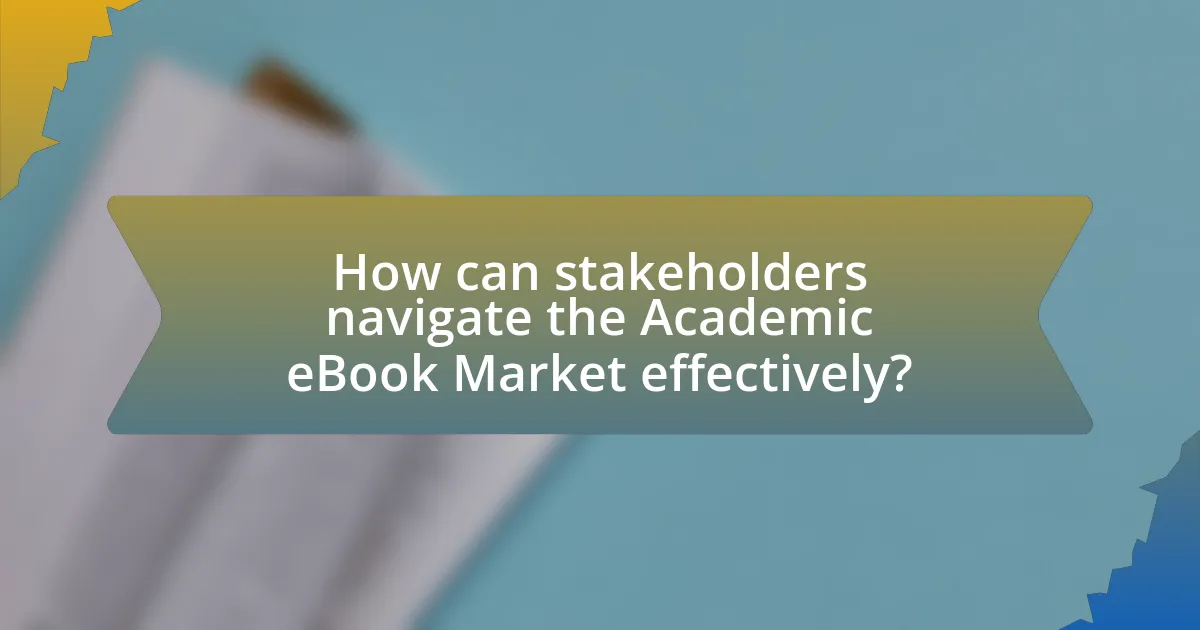
How can stakeholders navigate the Academic eBook Market effectively?
Stakeholders can navigate the Academic eBook Market effectively by leveraging data analytics to understand market trends and user preferences. Utilizing analytics tools allows stakeholders to identify which subjects are in demand, enabling them to curate relevant content that meets the needs of academic institutions and students. For instance, a report by the International Association of Scientific, Technical and Medical Publishers indicates that the global academic eBook market is projected to grow significantly, reaching $8.5 billion by 2025, highlighting the importance of informed decision-making in content selection. Additionally, stakeholders should engage in partnerships with educational institutions to gain insights into curriculum requirements, ensuring that their offerings align with academic needs. This strategic approach, supported by market research and collaboration, enhances the ability to compete effectively in the evolving landscape of academic eBooks.
What best practices should publishers follow in the Academic eBook Market?
Publishers in the Academic eBook Market should prioritize accessibility, quality content, and effective marketing strategies. Ensuring that eBooks are compliant with accessibility standards, such as WCAG, allows a wider audience, including those with disabilities, to engage with the material. High-quality content is essential; research indicates that well-researched and peer-reviewed materials are more likely to be adopted by institutions, as evidenced by a 2021 study from the Association of American Publishers, which found that 78% of academic libraries prioritize peer-reviewed content. Additionally, leveraging digital marketing techniques, such as SEO and social media engagement, can significantly enhance visibility and reach, with a report from Statista showing that 70% of academic eBook sales are influenced by online discovery. These practices collectively contribute to a more successful and sustainable presence in the academic eBook market.
How can publishers enhance accessibility and usability of academic eBooks?
Publishers can enhance accessibility and usability of academic eBooks by implementing features such as screen reader compatibility, adjustable font sizes, and alternative text for images. These features ensure that users with visual impairments can navigate and comprehend the content effectively. According to the Web Content Accessibility Guidelines (WCAG), adhering to these standards significantly improves the user experience for individuals with disabilities. Additionally, providing a user-friendly interface and intuitive navigation can further enhance usability, making it easier for all users to locate and engage with the material. Research indicates that 15% of the global population experiences some form of disability, highlighting the importance of these enhancements in reaching a broader audience.
What marketing strategies are effective for academic eBooks?
Effective marketing strategies for academic eBooks include targeted digital advertising, content marketing, and partnerships with educational institutions. Targeted digital advertising leverages platforms like Google Ads and social media to reach specific demographics, such as students and educators, increasing visibility and sales. Content marketing, through blogs, webinars, and social media posts, establishes authority and engages potential readers by providing valuable information related to the eBook’s subject matter. Partnerships with universities and colleges can enhance credibility and facilitate bulk purchasing or institutional access, as evidenced by the growing trend of libraries adopting eBook collections to meet academic needs. These strategies collectively enhance reach and engagement in the academic eBook market.
What tips can educators use to select the best academic eBooks?
Educators can select the best academic eBooks by evaluating the credibility of the publisher, assessing the relevance of the content to their curriculum, and checking for peer reviews or recommendations from colleagues. Credible publishers often have a rigorous editorial process, ensuring high-quality content. Relevance to the curriculum ensures that the eBook meets educational goals, while peer reviews provide insights into the eBook’s effectiveness and reliability. According to a study by the Association of College and Research Libraries, 78% of educators prioritize publisher reputation when selecting academic resources, highlighting the importance of these criteria in the selection process.
How can educators evaluate the quality of academic eBooks?
Educators can evaluate the quality of academic eBooks by assessing several key criteria, including the credibility of the author, the reputation of the publisher, the relevance and accuracy of the content, and the presence of peer reviews. Credible authors typically have advanced degrees and a strong publication record in their field, while reputable publishers are often well-known academic presses or institutions. Additionally, educators should examine the eBook’s citations and references to ensure the information is accurate and up-to-date. Peer reviews can provide insights into the eBook’s scholarly rigor and acceptance within the academic community. These evaluation methods are supported by research indicating that the quality of academic resources significantly impacts student learning outcomes and engagement.
What resources are available for finding academic eBooks?
Academic eBooks can be found through various resources including university libraries, online academic databases, and eBook platforms. University libraries often provide access to a wide range of academic eBooks through subscriptions to services like ProQuest and EBSCOhost. Online academic databases such as JSTOR and Google Scholar also offer access to numerous academic eBooks. Additionally, platforms like SpringerLink and Wiley Online Library specialize in academic content, providing extensive collections of eBooks across various disciplines. These resources are widely recognized in the academic community for their reliability and comprehensive offerings.







